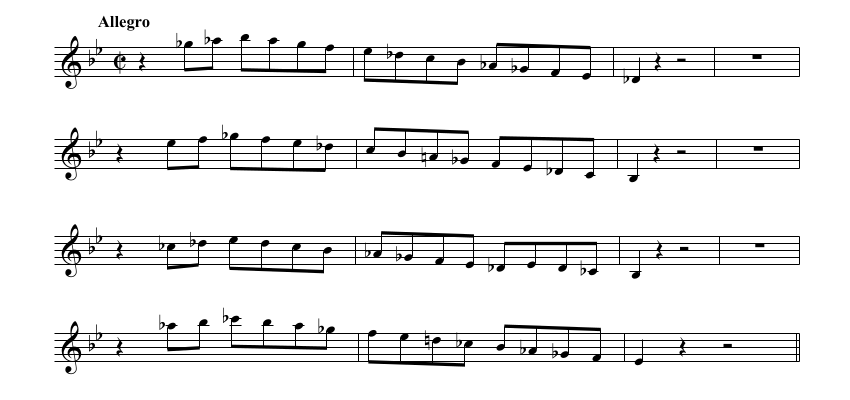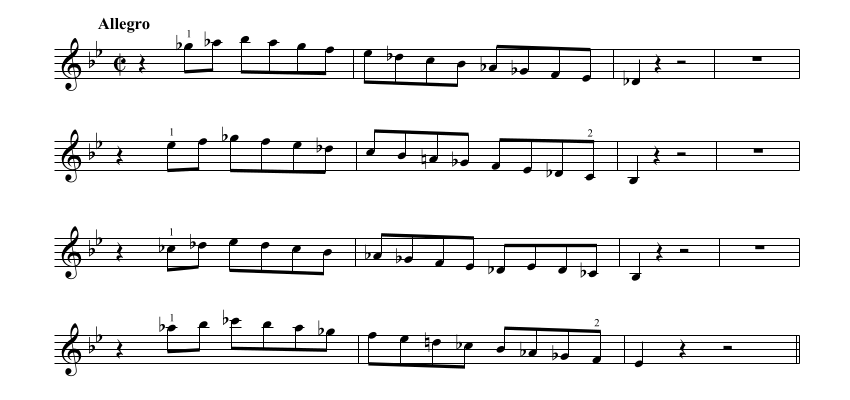Apply same fingering sets to each sequence
Let's say there is a passage like this:

We can play everything in the first position like so:

You see that the same pattern of notes are repeated three times here, so what if we apply the same fingerings for each pattern? Let's start with the 2nd finger in each measure, like this:

Now we are playing each measure with the same fingerings. This organizes the fingerings better, and makes it easier for you to play all these notes because you have to learn only one set of fingerings in one measure, and you just repeat them.
There are musical phrases that contain certain patterns in them. When you find one consider applying the same fingering set to each pattern. It might work very nicely. Let's check out some examples.
Examples
Here is the 1st example. This excerpt is from Schubert's Symphony No.5. What kind of fingerings would you come up with?

Did you come up with good fingerings? Here is what I did:

When you study the notes you will see that the way notes are going up and down are the same all 4 times, except for a minor difference at the end of the 3rd line. So I thought it may be a good idea to apply the same fingerings on each of them.
You might also notice that the interval pattern, or the spacings of the fingers, on the 1st line and 3rd line are the same, and that is also true for the 2nd and the 4th lines. This makes me think that I should use the same fingerings for the 1st and 3rd lines, also for the 2nd and 4th lines.
What finger should you start with if you can use the same fingerings for all of them? If you try starting with each finger, you will quickly realize that 3rd and 4th fingers are not the best fingers to start with for this passage. So our choice is either the 1st or 2nd finger.
I find starting with the 2nd finger more awkward because you have to cross strings in half steps in the 2nd and 4th lines (in the 2nd line, the string crossings are Db to C, and Gb to F). These string crossings occur in the half step. Half step string crossings are more difficult to play in tune than a whole step one because you have to reach further between the 1st and the 4th fingers.
In addition, there is an augmented 2nd in the 2nd and 4th lines (A and Gb in the 2nd line, D and Cb in the 4th line). If you started each sequence with the 2nd finger you have to play the augmented 2nd with the 1st and 2nd fingers. As you know, you have to stretch your fingers to play an augmented 2nd. This makes it even more difficult to play if you started each line with the 2nd finger.
The major advantage of staring each line with the 1st finger is that now you can cross strings in the augmented 2nd in the 2nd and 4th lines, which makes it so much easier to play the interval in tune. You'd have to cross strings in a half step in the 1st and 3rd lines, but that is not as awkward as crossing in half step in the 2nd and 4th lines.
By starting with the 1st finger for every entrance, the fingerings are all the same except for the last 2 notes in the 2nd and 4th lines where you need to shift down. This eliminates the complication of applying different fingerings on each line. You stick with one fingering set, and you can shift your focus to playing the notes in tune.
Let's look at another example. This excerpt is from the Clarinet Concerto by Mozart. What would you do?

Below is a somewhat typical fingering with no pattern applied:

Here is what I came up with:

When you study the notes it becomes apparent that the pattern of the 1st 8 notes is repeated each measure. Also, the pattern of the 2nd half of the 1st measure repeats in the 2nd measure. So I decided to apply the same fingerings for the same pattern of the notes. With these fingerings, the only exceptions are the E♮ in the 2nd beat of the 2nd measure and A♮ in the 3rd measure where an open string should be used.
A similar passage comes back later in the movement, and the same fingerings work well again.

You will end up shifting more often than some other fingerings but all you need to think about is one fingering set to play all of these passages. It simplifies your tasks when you keep things organized. Then you can pay attention to other things such as ensemble, intonation, phrasings, etc..
Let's go for another example. This excerpt is from the 1st movement of the "Dissonance" Quartet by Mozart.

You can see that same fingerings are applied to the same patterns of the notes. By applying the same fingering sets to the same sequence of notes, you can also organize the musical structure as well.
Now, let's try an excerpt from Symphony No.5 by Sibelius. Take a look at the example below.

What kind of fingerings will you assign? Do you see a pattern? See if you can come up with good fingerings. Here is what I would do:

There is a pattern in every two measures. The interval between the first two notes is either an augmented 4th or a diminished 5th, which are essentially the same intervals. Then the note goes down by an octave, then back to the first note.
You can apply the same fingerings when you start every two measures with the 1st finger. Because this passage involves many augmented and diminished intervals, you will end up playing out of tune if you don't organize your fingerings.
Summary
Some of these fingerings may look a little more complicated than when you would slide your fingers or shift between 1st and 3rd positions all the time. However, when you spend some time with them you will find that these fingerings make sense, and they will prove to you that it is actually easier to play in the end.
Most of the time, when there are patterns in fingerings you will also find patterns in the musical structure. When there is a musical structure associated with fingering patterns, you can use each pattern as a building block to shape a longer phrase. For instance, you can make crescendo to the next block each time, or you can play the first two blocks the same way and do something different for the third block. Finding fingering patterns will not only help you organize technically, but also it will help you musically.
Though these are examples of applying the same fingerings for the same patterns of notes, this approach will not always work. We have to examine each case and determine whether or not this method would work.